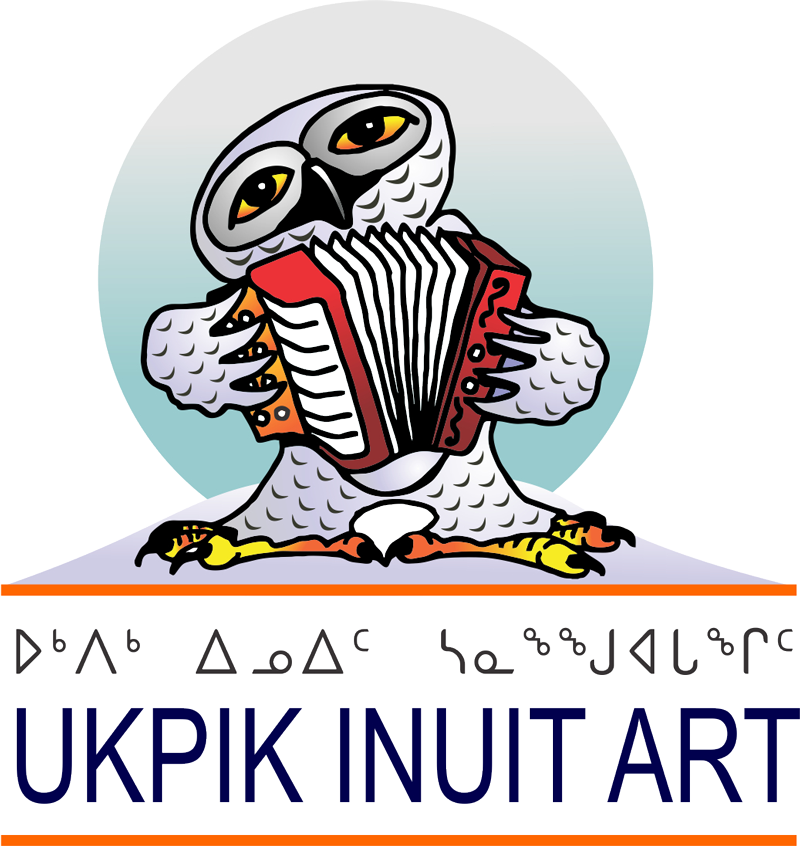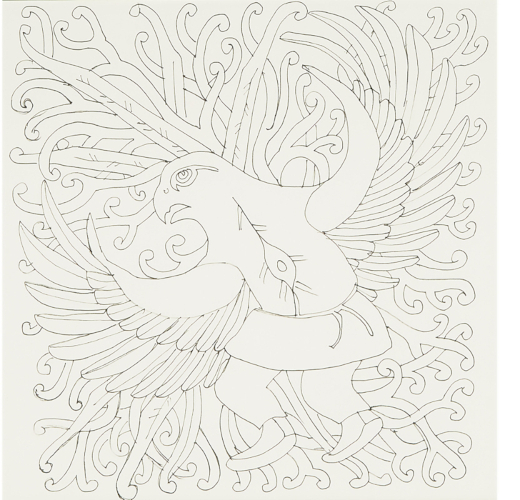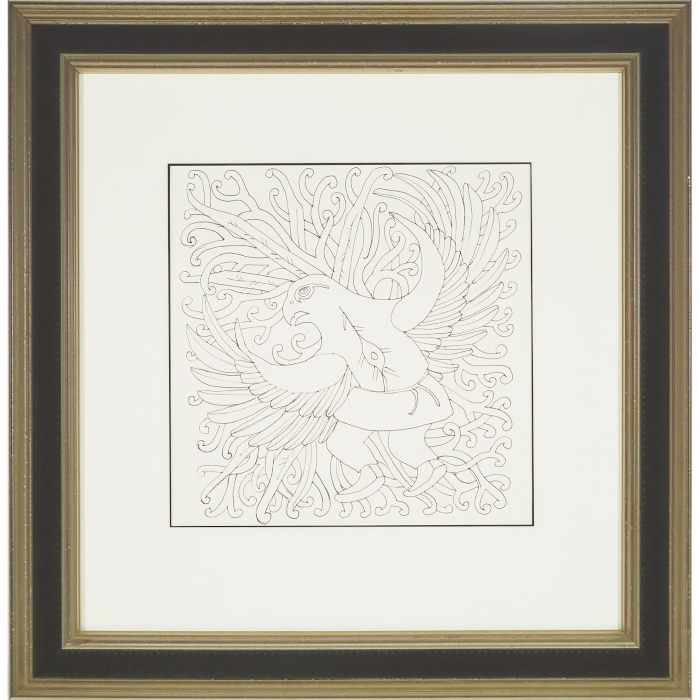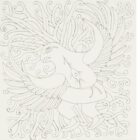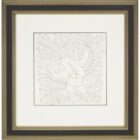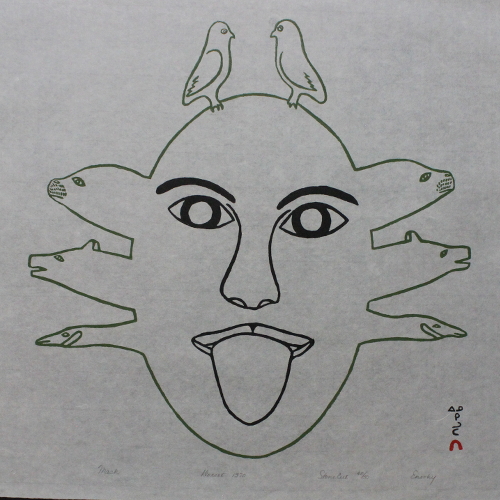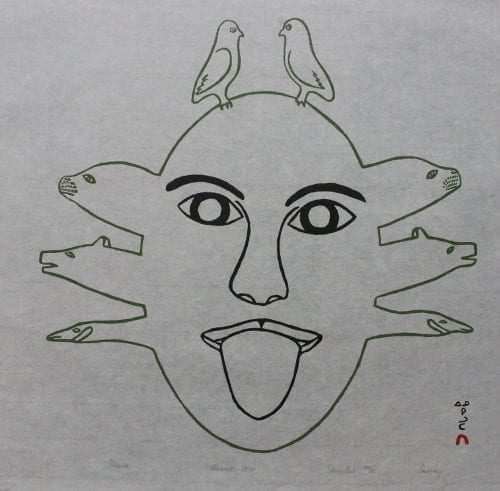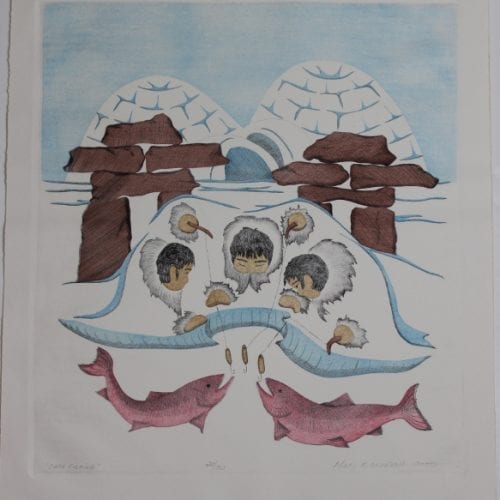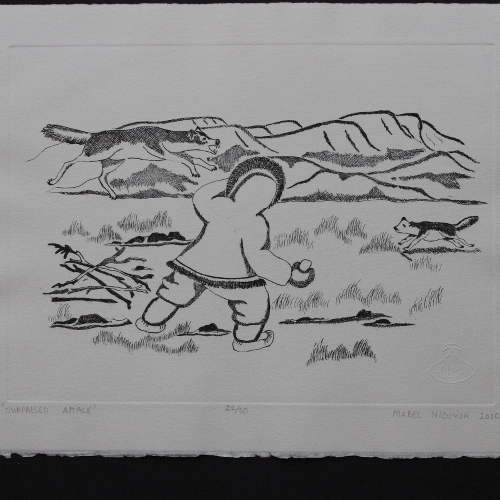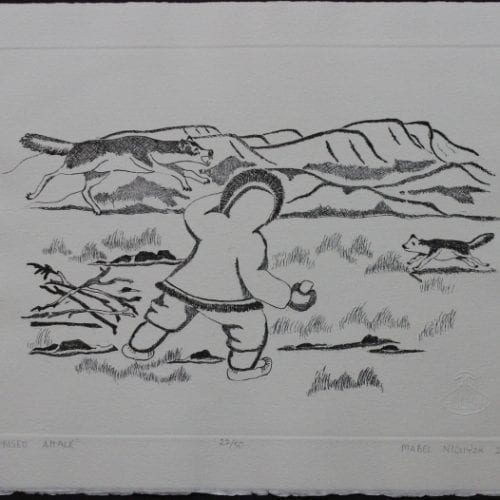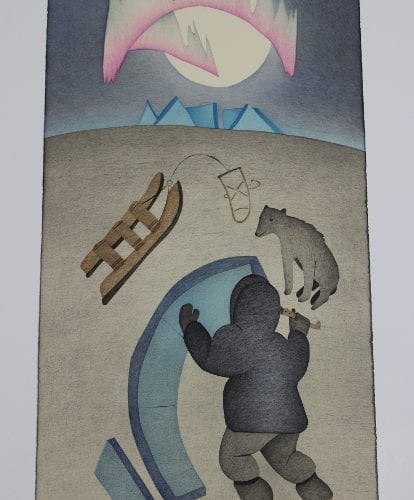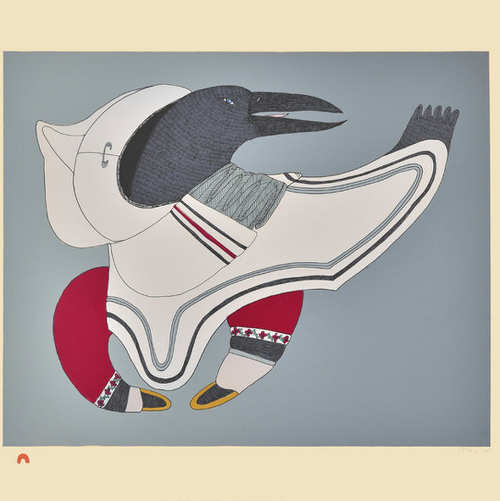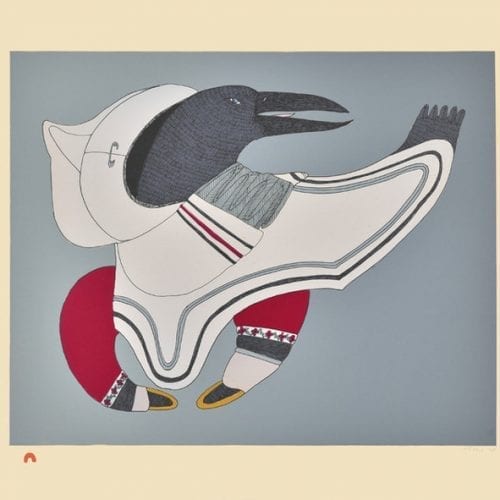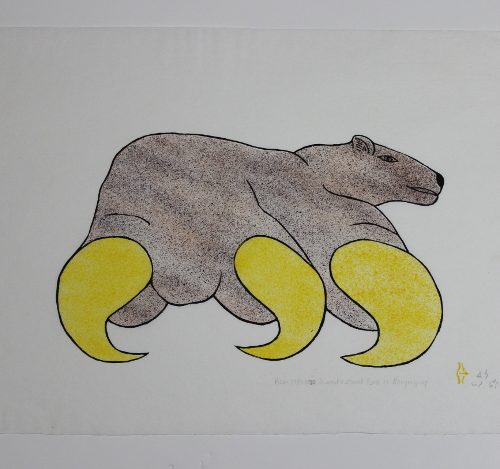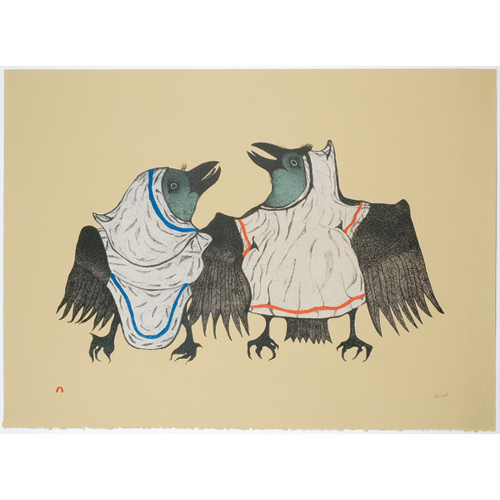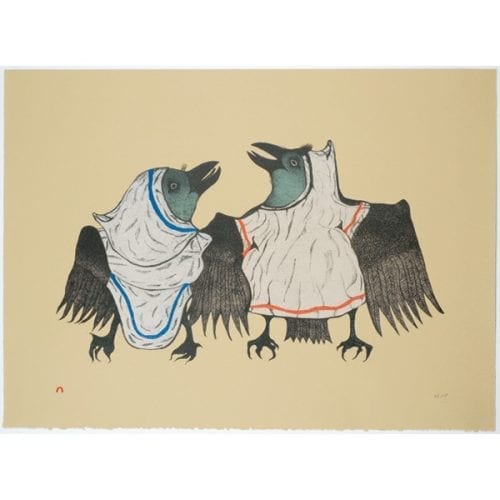Biography Abraham Apakark Anghik
Abraham Apakark Anghik, ᐊᐃᐊᔭᑲ ᐊᐸᑲ ᐊᒋ
Settlement: Paulatuk
(1951) — W3-1205
First Name: Abraham Anghik
Last Name: Ruben
Full Name: Abraham Anghik Ruben
Name in syllabics: ᐊᐃᐊᔭᑲ ᐊᐸᑲ ᐊᒋ
Date of birth: November 26, 1951
Place of birth: Paulatuk, Northwest Territories, Canada
Powerful, compelling, exquisite are but a few of the words to describe the work of master sculptor Abraham Anghik Ruben. Stories, myths and legends of ancient Northern cultures find new life and expression through his work. Linked by strong narratives, his sculptures speak of cultures lost and times forgotten.
Abraham was born in 1951 in a camp south of Paulatuk, Northwest Territories and east of the Mackenzie River Delta. This region is home to the Mackenzie Inuit or Inuvialuit. The late 1890s would see the arrival of large-scale commercial whaling fleets into the region soon followed by an influx of Inuit from Alaska.
Abraham’s own great-grandparents, noted shamans Apakark and Kagun came from the Bering Sea region of Alaska during this time. Abraham pays tribute to them in the sculpture Apakark and Kagan-Journey to the Underworld (plate 14). By the time of Abraham’s birth, Inuit culture was in the midst of a profound change that would forever alter their traditional way of life and set the stage for Abraham’s lifelong quest to re-discover and connect with his roots.
Up until the age of 8 Abraham lived with his family on the land migrating with the changing patterns of the seasons. As it had been for thousands of years, life was hard and the family needed to rely on the skills and efforts of all members to ensure survival in one of the harshest environments on earth. In 1955 this existence was to change dramatically for Abraham when heartbreaking time for the family is eloquently captured in The Last Goodbye. This same scene would be repeated again when Abraham and his other brothers were themselves sent away. This sadness and horror of life at these schools would come to light many years later, but for Abraham the pain endured during those eleven years came early and would continue to haunt him throughout his life as we see in Wrestling with my Demons.
Abraham’s quest to reconnect with his past found artistic form in 1971 when he attended the Native Arts Centre at the University of Alaska studying under Ronald Senungetuk. Throughout the 1970s Abraham pursued a career as an artist working in the varied media of sculpture, jewelry, prints and drawings. He would soon catch the attention of art dealers across Canada including Jack Pollock who showed his sculptures at his gallery in Toronto in a series of solo exhibitions.
In 1986 Abraham moved to Salt Spring Island where he continues to live and work with his wife Patricia Donnelly and their children. Since that time, Abraham’s interests in exploring the stories, myths and legends of his ancestors have found artistic form in a multitude of works, which have been exhibited and collected internationally. His quest has also led in recent years to the exploration of other cultures and people who inhabited the Northern hemisphere. In his last solo exhibition, curated by Darlene Coward Wight at the Winnipeg Art Gallery in 2001, Abraham stated that:
I have always tried to learn from others, either Inuit or other elderly people who can pass on their knowledge of what life is about. I try to put that into my sculpture.
Abraham’s mother’s aunt, Paniabuluk, assisted Arctic explorer Vilhjalmur Stefansson on many of his expeditions. She became his Inuit wife. Stefansson, the son the Icelandic immigrants, was born in Manitoba in 1879 and spent the winter of 1906-07 living with the Mackenzie Inuit. In 1928 Captain Larson of the St. Roche spent the winter in Langton Bay with Abraham’s grandfather Ruben Anghik and his family. These historical family connections inspired Abraham’s interest in people of the Nordic countries.
In late 2004, while recovering from an ordeal with cancer, Abraham gained a new perspective on life that enabled his artistic practice to reach a new high.
Many of the sculptures in the years since 2005 centre on Abraham’s interest in the relationship between the Inuit and the Viking Norse Centuries before European explorers “discovered” North America the Vikings set sail along the icy waters from their Scandinavian homelands eventually finding their way to the shores of what is now Canada. The powerful works To the North Western Shores (plate 10) and Odin (plate 5) dramatically recounts these voyages. The parallels between these works and Inuit stories of migration are striking. Men, women, and children travel together by boat with all of their worldly possessions in search of better lands in which to live bringing along with them their culture and spiritual beliefs. In these works, the wooden, dragon prowed ship of the Norse replaces the traditional Inuit umiak.
As a storyteller, Abraham builds upon that which he already knows. From his own perspective, he tells the stories of these encounters between Inuit and Viking Norse. Abraham sees great similarities between the two cultures including the practice of shamanism and a respect and reverence for the land He seeks to bring to life the experiences of the Vikings in North America from a contemporary view – stories, which have not yet found a voice.
The sculpture Goddesses of the Northern Seas (Sedna and Ran) represents the spiritual encounter between these cultures. Sedna and Ran are counterparts in their respective cultures, both governing the seas. Abraham brings the two together as symbols of the cultural and spiritual exchange, which he believes occurred between Inuit and Viking. Similarly, Ancient Memories I and II (plates 8-9) reference the essential role of storytelling and communion in both cultures.
Researching Norse culture and reading Icelandic Sagas provided Abraham with new narratives in which to add his own interpretation. Born of Ice and Fire (plate 1) represents the first Viking Norse colonists to Iceland whose God of choice was Thor, dramatically rendered by Abraham in Thor 900 AD. Norse design motifs enhance the sculpture and are used by Abraham to greater or lesser extents in works dealing with this theme.
Abraham’s earlier fascination with Inuit subjects has not been forgotten finding new expression in works such as Shaman’s Dream, (plate7), Shaman beckoning Sedna (plate 13), and Angatkok and Sedna (plate 11). In the dramatic work Odin, Shape Shifter (plate 6) Inuit and Viking beliefs intertwine with reference to the shamanic abilities of this powerful Norse god. Odin is represented in the various animals and birds, which he is known to have transformed into.
It is this interest in the parallel cultures of Viking Norse and Inuit that has resulted in some of the most powerful works that Abraham has ever produced. Bold, dramatic and expertly rendered, Abraham has honed his talent to a new level – we are witnessing an artist at his peak.
ARTIST’S STATEMENT
The Inuit believed in the existence of the Soul in all living things. The concept of reincarnation was central to family and community beliefs.
As a vigorous group of Arctic people, the Inuit came from west to east in wave after wave of nomadic bands in search of new land and game. With the re-curved Asiatic bow and toggle harpoon they hunted sea and land mammals. They traveled by kayak and umiak in summer and by dog team in winter.
The Inuit Shaman acted as mediator between the world of man, animals, and the spirit world. He was the keeper of Inuit stories, myths and legends …the repository of knowledge of the land and the secret worlds.
The Viking Norse came into North America by way of migrations from their Scandinavian homelands through the British Isles, Ireland and the Northern Islands, Iceland and then Greenland. They had highly developed religious, spiritual, and cultural beliefs and artistic traditions.
The Viking Norse had a mythological landscape inhabited by gods and goddesses, giants, monsters and demons. Their sagas speak of their Shamanic beliefs.
In Iceland, as a Greenland, the Viking Norse gave names to places and things that held power in their imagination. They used the spirit names of the mountain, river, stream, valley and forest – protective spirits and malevolent ones as well.
My sculptures portraying Viking Norse myths, stories and legends have Norse decorative lines and motifs. These are designs that I have adapted and changed to enhance the visual impact and to convey the sense of belonging to that place and time.
As a storyteller, I have sought to bring life to these ancient voices from a time when these two northern people held a reverence for the land and for all living things therein that provided sustenance and survival.
Solo Exhibitions
2015-2016 Prince of Wales Northern Heritage Centre, Yellowknife, NT. Aurora Borealis: Abraham Anghik Ruben
2014-2015 Museum Cerny Inuit Collection, Bern Switzerland. Abraham Anghik Ruben “Moving Forward: Breaking Through”
2014 Rockwell Museum of Western Art, NY, USA. Abraham Anghik Ruben:The World of Man, Animals and Spirits
2013 Art Gallery of Algoma, Sault Ste. Marie, Ontario. Arctic Journeys/Ancient Memories: The Sculpture of Abraham Anghik Ruben
2012-2013 Arctic Journeys / Ancient Memories, The Sculpture of Abraham Anghik Ruben
Smithsonian, National Museum of the American Indian, illustrated catalogue Washington DC
2012 Hazelton Fine Art Gallery, Toronto
2010 Abraham Anghik Ruben: Shaman’s Dreams, Art Gallery of Mississauga, illustrated
catalogue. Mississauga, Ontario
2009 Abraham Anghik Rubin, Kipling Gallery, Woodbridge Ontario
2008 Abraham Anghik Ruben: Myths, Stories, Legends, Illustrated catalogue, Kipling Gallery, Woodbridge. Ontario
2003 The Art of Abraham Anghik Ruben, Appleton Galleries, Vancouver, BC
2001-2002 Abraham Anghik Ruben, Illustrated catalogue, The Winnipeg Art Gallery
2000, Paiges Art Gallery, Ketchum, Idaho
2001, Paiges Art Gallery, Ketchum, Idaho
2002 Paiges Art Gallery, Ketchum, Idaho
1998 Maslak -McLeod, Santa Fe
1994 Abraham Anghik: Works in Bronze, The Isaacs/Innuit Gallery, Toronto
1991 “Spirit of My People:” Sculptures by Abraham Anghik, The Alaska Shop, New York
1981 Images for a Canadian Heritage, Vancouver
1980 Abraham Anghik – New Sculptures, The Pollock Gallery, Toronto
1980 Bayard Gallery, New York
1979 The Pollock Gallery, Toronto
1978 The Pollock Gallery, Toronto
1977 The Pollock Gallery, Toronto
Two-Person Exhibitions
2012 Abraham Ruben & Ron Senungetuk, Bunnell St. Gallery Alaska
1989 Out of Tradition: Abraham Anghik/David Ruben Piqtoukun, Illustrated catalogue, The
Winnipeg Art Gallery
Group Exhibitions
2013 100 Masters: Only in Canada, Winnipeg Art Gallery
2013 Creation & Transformation: Defining Moments in Inuit Art WAG
2012 Canadian Heritage Gallery, Kleinburg Ontario2011 Inuit Modern, Art Gallery of Ontario AGO
2010 The Winnipeg Art Gallery
2010 Canada’s Northern House, Winter Olympics 2010, Vancouver, BC
2007 National Gallery, Touring Exhibition, Inuit Sculpture Now
2007 ItuKiagattal! Inuit Sculpture from the Collection of the TD Bank Financial Group, Guest
Exhibitor, Victoria Art Gallery
2005 Iceland 1000 AD, Mayberry Gallery, Winnipeg
2004 Noah’s Ark, National Gallery Shawinigan Quebec
1997 Sun Valley Centre for Arts and Humanities, Ketchum, Idaho
1995 Canadian Inuit Sculpture: The Next Generation, Orca Aart Gallery, Chicago
1993 Arts from the Arctic, organized by the Canadian National Committee, Arts from the Arctic
and Prince of Wales Northern Heritage Centre, Yellowknife
1993 Arts from the Arctic, Anchorage Museum, Anchorage, Alaska, Yakutsk Art Centre,
Yakutsk, Republic of Sakha, Siberia
1987 Orcas Gallery, Salt Spring Island
1984 Images Art Gallery, Toronto
1984-88 Arctic Vision: Art of the Canadian Inuit, Department of Indian Affairs and Northern
Development, Ottawa. Tour of United States and Canada
1983-85 Contemporary Indian and Inuit Art of Canada, Department of Indian Affairs and
Northern Development, Ottawa
1982 New Work by a New Generation, Norman Mackenzie Art Gallery, University of Regina,
Regina
1982 Recent Works by Anghik, Morriseau, Odjig, Thomas, Gallery Quan, Toronto
1982 Works by Abraham Anghik, David Piqtoukun, Stefanie Ham, Gallery Quan, Toronto
1981 The Inuit Sea Goddess, Surrey Art Gallery, Surrey
1981 Gallery Quan, Toronto
1980 National Museum of Man, Ottawa
1980 Children of the Raven Gallery, Vancouver
1979 Royal Ontario Museum, Toronto
1978 The Coming and Going of the Shaman, The Winnipeg Art Gallery, Winnipeg
1977 Art Gallery of Ontario, Toronto
1975 University of Alaska, Fairbanks, Alaska
Public Collections
The Rockwell Museum, Corning, New York, USA
Art Gallery of Algoma, Sault Ste. Marie, Ontario
Art Gallery of Nova Scotia, Halifax, Nova Scotia
Beaverbrook Art Gallery, Fredericton, New Brunswick
Museum Cerny Inuit Collection, Bern Switzerland
Art Gallery of Ontario AGO, Toronto, Canada
Canadian Embassy, Washington DC
Canadian Museum of Civilization, Ottawa
De Young Museum – Fowler Collection – San Francisco
Glenbow Museum, Calgary
House of Commons, Ottawa
Indian and Northern Affairs, Canada, Ottawa
McMaster University Art Gallery, Hamilton
McMichael Canadian Art Collection, Kleinburg, Ontario
Museum of Anthropology at the University of British Columbia
Museum of Inuit Art, Toronto
National Gallery of Canada, Ottawa
Norwegian Folk Museum, Oslo, Norway
Prince of Wales Northern Heritage Centre, Yellowknife
Royal Ontario Museum, Toronto
The Winnipeg Art Gallery, Winnipeg
University of Alaska, Board of Regents, Juneau, Alaska
The University of Manitoba, Winnipeg, Manitoba
The Vancouver Art Gallery, Vancouver, British Columbia
Corporate Collections
The Richardson Group, Winnipeg
Kingswood Capital, Vancouver
Alberta Stock Exchange, Calgary
Terasen Gas Building, Vancouver
Glaxo Smith Kline, Mississauga
Alcan World Headquarters, Montreal
BC Chartered Accountants Building, Vancouver
Imperial Oil Ltd., Alberta
Labbatt’s Ltd., Ontario
Citicorp, Toronto
BMW Canada, Ontario
PowerOne Capital Markets ltd., Toronto
Pinetree Capital Ltd., Toronto
Sprott Asset Management, Toronto
Private Collections
Gary and Carol Leach, Salt Spring Island
Trish and Larry Kubal, San Francisco
Anthony von Mandel, Vancouver
Lorne Balshine, Vancouver
Mrs. Selznik, Ketchum, Idaho
Don Klune, Ketchum, Idaho
Joseph Segal, Vancouver
Sheldon Inwentash Lynn Factor, Toronto
Pat DiCapo, Toronto
Eric Sprott, Toronto
Arthur Block, Vancouver
Leon Kahn, Vancouver
Martin Goldfarb, Toronto
Klamer Family, Toronto
John Adams, Vancouver
Dr. J. Hyman, New York
Martha Marston, Dallas
Tommy Chong, Paris, France
Alex de Figueiredo, Vancouver
Christian Steckler
Sam and Esther Sarick
Cas Morel, Calgary
Pannese Family, Woodbridge, Ontario
Panetta Family, Vaughan, Ontario
Nick Melatti, Richmond Hill, Ontario
Anita Zumerle, Maple, Ontario
Albert Bozzo, Woodbridge, Ontario
Ruffolo Family, Nobleton, Ontario
Nick Tsimids, Richmond, Hill, Ontario
Dr. and Mrs. Greenspan, Thornhill, Ontario
Mark Di Poce, Kleinburg, Ontario
Bruno and Paula Zaina, Woodbridge, Ontario
Heather M. Beecroft, Toronto, Ontario
Mr. Mrs. Robert Oliva, Kleinburg, Ontario
Mario Pestrin, Kleinburg, Ontario
Mr. Mrs. Peter Belinda Priede, Kleinburg, Ontario
Mr. Bill Shepherd, Oshawa, Ontario
Acknowledgements
The exhibition, Arctic Journeys, Ancient Memories: Sculpture of Abraham Anghik Ruben has received generous financial and material support from the following:
Colour Innovations Inc.
Sprott Asset Management LP
Ready-Weld Metal Fabricators Inc.
George Kriarakis & Associates Ltd.
Troshan, Inc.
Venture Metal Works Inc.
Publications
June 2008 “From the Spirit”, Documentary, Bravo AE
Honours and Achievements
Expo 86, Banner and backdrop for NWT Pavillion performance stage, Vancouver, Canada 1986
National competition for GlaxoSmithKline Canadian Headquarters – 16′ limestone sculpture, Northern Myth Northern Legend 1990
Instructor for Inuit Artists’ College sculpture workshop in Ottawa, 1991
Manulife national sculpture competition for placement at BC Gas Building, Vancouver, Canada 1993
Chair, Canadian National Committee for the organization of the circumpolar exhibition, Arts from the Arctic.
Holocaust Sculpture Memorial, Holocaust Museum, Jerusalem, Israel, 1992 – ongoing
National competition for University of Manitoba’s Aboriginal Student Centre, 7 1/2′ bronze sculpture.
2010 Winter Olympics, North West Territory Pavilion, Interpretation of the Winter Games in bronze.
